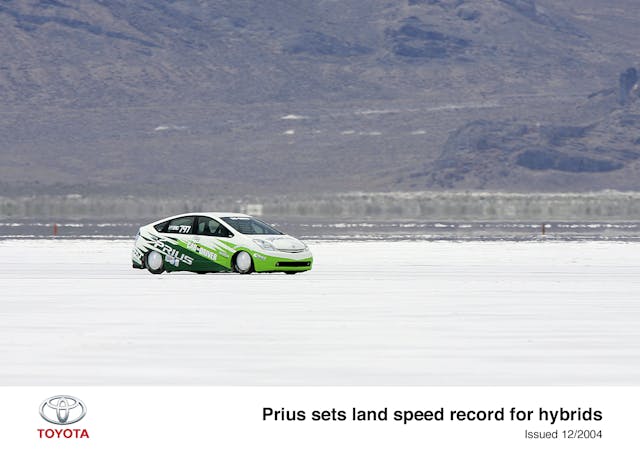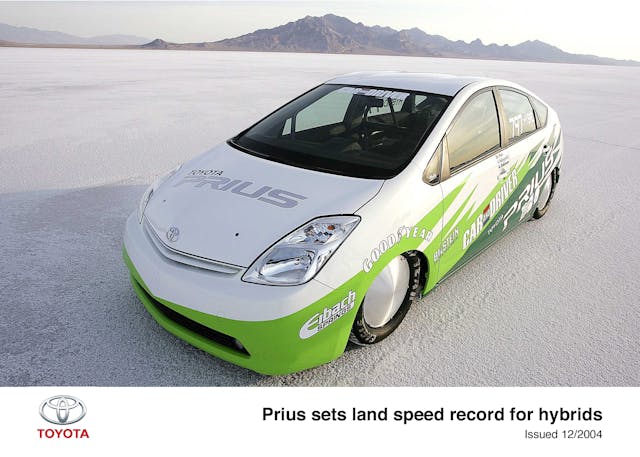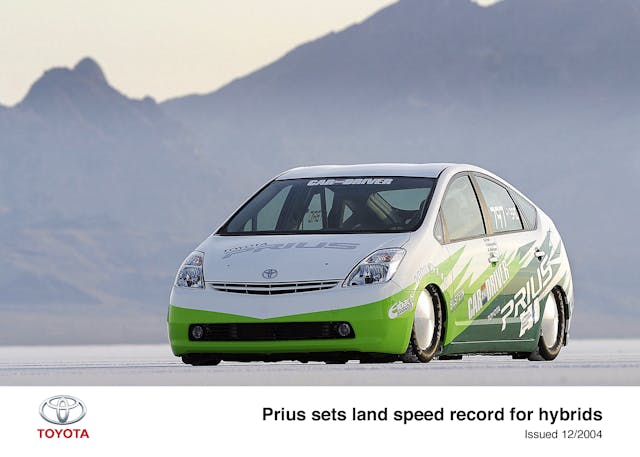Media | Articles
This Prius Set a 130-mph Record, and Now It’s Going to the Crusher
Although people travel to the Bonneville Salt Flats in western Utah to drive fast, there is really no place quite like it on Earth to make you feel slow. The broad, incredibly flat salt playa that hosts the annual Bonneville Speedweek (as always, weather permitting) is a featureless moonscape that has no reference points to indicate motion. The surrounding mountains are so distant that their bases are concealed below the arc of the horizon, and except for the course markers at every milepost that whisk past, there’s no sensation of motion save for the plink-plink of salt crystals spraying in the wheel wells.
Back in 2003, some sharp minds at Toyota figured out that of the 600-plus classes at Bonneville, none was for gasoline-electric hybrid cars such as its hot-selling Prius. Further, as long as the Southern California Timing Association (SCTA), which hosts Speedweek, was willing to create a class, a car could go 300 mph or 30 mph and still set a record. I was then an editor at Car and Driver magazine and having drinks one night with Bill Reinert, then Toyota’s U.S. manager of advanced technologies. He let slip the Bonneville plan and I volunteered, without asking my boss, a full spread in Car and Driver if Toyota let us drive it.
While negotiations commenced with SCTA, a team in Los Angeles headed by Chuck Wade, who built special vehicles for Toyota including all of its Toyota Pro/Celebrity race cars, was tasked with modifying a stock 2003 Prius for Bonneville. Which involved gutting the car, lowering it, and fitting huge Mickey Thompson salt-flat tires and disc wheels.

It sounds simple enough, but it proved to be incredibly complex thanks to the Prius’s hybrid powertrain. The entire transmission had to be “clocked” relative to the engine to bring the driveshaft power-takeoffs lower, or else the CV joints would be eaten by the extreme angles. That created a rat’s nest of interference issues that had to be worked out. A large fluid tank in place of the passenger seat would be filled with ice and water just before the run in order to cool the car’s power electronics, and a bar was fixed to the back bumper so the Tacoma push-truck could nudge the Prius off the line.
Only a few months later we were out on the salt flats sweating under the intense sun as the lowered, gutted, and striped Prius was made ready for its first run. I would take the first pass, followed by Prius chief engineer Shigeyuki Hori, and then Toyota vice president Fumiaki Kobayashi. All three of us shared billing on the side of the car, above prominent Car and Driver logos.
Marketplace
Buy and sell classics with confidence
Belted in, I looked down the five-mile short course while I awaited our turn off the line. As we rolled up to take our run, the car suddenly refused to shift from neutral to drive. Our crew chief, Bonneville veteran and Toyota engineer Jim Leininger, yanked open the door and barked commands: “Press the brake once! Floor the gas three times! Press the brake again and try it!” Nothing worked, and while the starter grew impatient at this larval computer pod stalled at his line, we frantically rebooted the car and tried again. Finally, the Prius’s five-or-so computers reached agreement and the car shifted into drive. The Tacoma pushed me off the line and, when Jim honked the horn at 40 mph, I floored it.
While the stock Prius back then was computer-limited to 104 mph, the goal was to squeeze the Bonneville Prius over 130, a figure calculated based on its horsepower and very slippery drag coefficient. The car accelerated fairly lazily and without drama, and I had time to look around at the sun-drenched salt, the bustling pits that were passing way in the distance off to the left, and the mountains rising from the horizon. The narrow tires sounded like skis whisking through fresh snow, the salt clattering against the bottom of the car. Crossing the line, the in-car radio reported the speeds: 130 mph at the start of the measured mile, 131 mph a quarter of the way through, and 129 mph out the back door, for an average of 130.794 mph.
Later, for fun, because it was illegal for the purposes of setting a record, the team taped up the front-end openings and got 134 mph out of the Prius. Smiles and “banzais” all around. The Prius was shipped back to Japan, where Hori managed to crash it while showing it off on a racetrack (because of the oversized wheels, the steering was never able to turn more than a few degrees). Toyota thought it would crush it then, but back in Los Angeles, Wade volunteered to rebuild the car and it was shipped back to the U.S. Following the rebuild, the Prius lived a quiet life in Toyota’s museum in Torrance, California, before the company moved it to Texas.

The best part of the whole thing was that Toyota purchased full-page ads for its feat in all of the major car magazines, which meant that readers of our competitors at Motor Trend, Automobile, and Road & Track at some point came across a large Car and Driver logo emblazoned across the side of the Bonneville Prius in each of those magazines. Not that it got me a raise or anything.
Now the car has been marked for destruction by Toyota and spotted in a recycling yard outside Dallas. The conditions at Bonneville are extremely hard on a car, and corrosion has likely done a number on this racer. The Prius is also potentially un-registrable due to being built from a car that might never have been prepped to sell. Regardless, we say kudos to you, brave hybrid, and may you set a record on that first run at the salt flats in the sky.
***
Check out the Hagerty Media homepage so you don’t miss a single story, or better yet, bookmark it. To get our best stories delivered right to your inbox, subscribe to our newsletters.














Done up like this not only makes this the best-looking early Prius I have ever seen but for some reason connect me to “Nash Metropolitan”.
If it’s too rusted to race I suppose… but it seems a shame to crush it. Ship it to the Mighty Car Mods guys and they would do something with it…
I’d happily take it on. I’ve already got a concept car that needed saving and this would be a great bedfellow. Feel free to get in touch
If it is rusty is day little about the construction of the car. Many cars run for years there with no major rust issues.
I suspect that now the project is done it is just being scrapped for liability reasons. If it was sold and crashed Toyota did not want the liability for it.
Many automakers cars meet their end like that.
The salt is brutal on clean cars.
I’ve seen doors and rockers rot out from the salt getting kicked up through the drain slots.
I spent 2 years back east and a 20 year old desert truck was rendered virtually worthless from rust. I should have stored it in AZ and bought a local truck with patina rust.
It was a fun PR event but I can’t get too excited over a Prius. At least it went off script and did maximum speed runs.